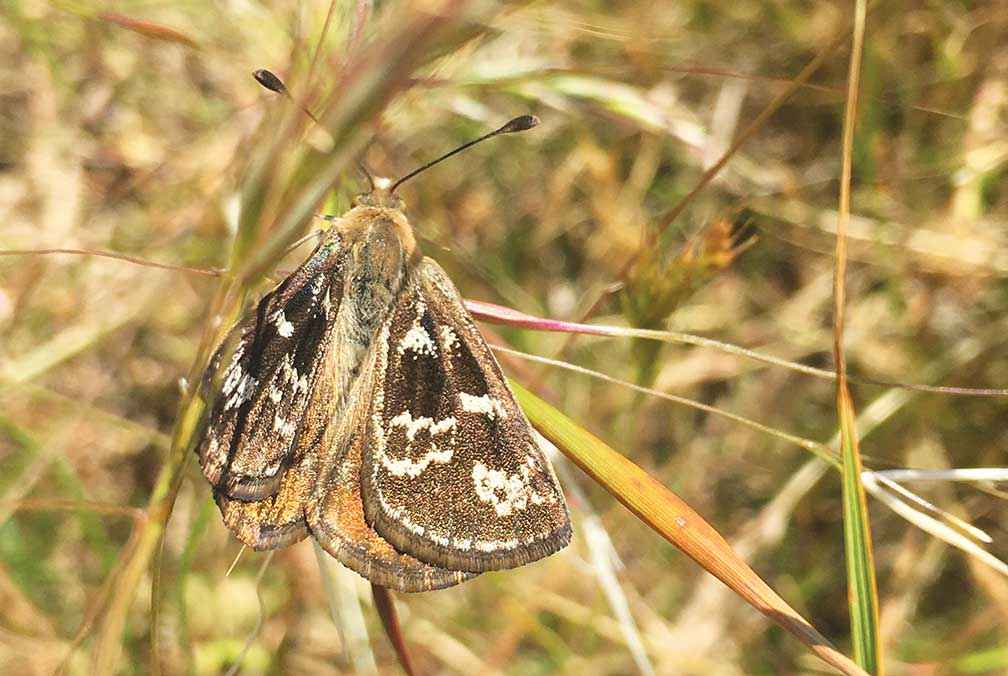Victorian Landcare Magazine - Winter 2022, Issue 84

On a warm summer day in 2021, Karen O’Keefe was out walking on her Rokewood property when she noticed a moth flying erratically, zigzagging a few feet off the ground. The moth landed on a thicket. She noticed its bronze-brown forewings and her heart leapt. Could it be a golden sun moth?
Rokewood is in the Victorian Volcanic Plains (VVP) bioregion of south-west Victoria, one of Australia’s richest biodiversity hotspots. As Regional Agriculture Landcare Facilitator with the Corangamite CMA, Karen travels across the volcanic plains helping primary producers to manage their land sustainably.
Karen sent her photographs of the moth to several colleagues, who confirmed it was indeed a golden sun moth. Once common across the native grasslands and grassy woodlands of south-eastern Australia, intensive agricultural practices and urban development have greatly reduced the moth’s habitat and impacted on breeding cycles. Females are unable to travel between isolated grassland patches to breed, and adult males will not fly more than 100 metres from suitable habitat. The moth is listed as vulnerable in Victoria.
Like many moths and butterflies golden sun moths are dimorphic, meaning that males and females have distinctive markings. Karen soon realised her paddocks, with remnant patches of native wallaby grass (Rytidosperma sp.) and spear grass (Austrostipa sp.), were home to an entire population of golden sun moths. She observed females with golden-splashed backs crawling on the ground among the grass and bronze-brown males actively flying around in search of females.

Above: A male golden sun moth.
Karen knew how important it was to capture and officially record sightings of threatened species, in order to increase our knowledge and understanding of species.
“This is a crucial step to ensure habitat is protected into the future, and that appropriate considerations can be made if significant land use changes are proposed to occur at the site. It is also fun finding and recording new populations of species not previously recorded at a site,” Karen said.
Still buzzing from the excitement of her discovery, Karen opened the VBA Go app on her phone and uploaded her sightings to the Victorian Biodiversity Atlas (VBA). The VBA is the foundational dataset for Victoria’s native species. It provides a comprehensive spatial record of the distribution, abundance and conservation status of wildlife across the state.
The Victorian Biodiversity Atlas is the foundational dataset for Victoria’s native species.
Data from the VBA feeds into DELWP’s biodiversity decision support tools including NatureKit and Strategic Management Prospects (SMP), which are utilised within government and across the conservation sector for planning, monitoring and reporting of on-ground actions for biodiversity conservation.
There are currently 10 million species records in the VBA, with some records dating from the 1800s when botanist Ferdinand Von Mueller established the National Herbarium of Victoria. The VBA is an invaluable dataset for showing where wildlife is now and how
it has changed over time.
Anyone can use the VBA. All data published is also in NatureKit which allows users to easily search for, and map species, and check for threatened species in their area. Recording confirmed species sightings in the VBA is vital for helping to monitor the impact of on-ground actions, to improve decision making and to measure progress towards the ambitious targets
of the state’s Protecting Victoria’s Environment – Biodiversity 2037 plan.
Every record counts for conservation, and adding your species sightings to the VBA is a practical step we can all take to support investment, regulation and management decisions that protect Victoria’s environment.
According to Mel Hardie from the VBA team at DELWP, every record entered in the VBA goes through a quality assurance process to check that the information is complete and meets data standards.
“Species specialists then individually verify the species identification, based on location and methodology and other supplementary information. We need high-quality data for our decision support tools such as SMP. All sightings help to improve our collective knowledge of species in Victoria.
“We are particularly interested in species sightings from regional surveys, carried out over several years, and where there are known data gaps. For example, we have very good data on bird populations, but not as much data on invertebrates in farming regions,” Mel said.
Mel encourages Landcare groups that have species surveys and sightings they want to upload to the VBA to get in touch with the team who will be happy to assist.
For more information about VBA and to download the VBA Go mobile app visit https://www.environment.vic.gov.au/biodiversity/victorian-biodiversity-atlas/vba-go
Sarah Martin is a Project Officer for the Protecting Victoria's Environment - Biohdiversity 2037 plan at DELWP.
For more information contact the VBA team at vba.help@delwp.vic.gov.au
Native grasslands once covered 2.3 million hectares of the VVP. Since colonisation the grasslands have been extensively cleared for agriculture and less than one per cent remains.
The Corangamite CMA’s Grassy Eucalypt Woodlands Stewardship Program (supported by the Australian Government’s National Landcare Program) partners with community groups, including the Geelong Landcare Network, to support landholders in conserving VVP habitat Several field days were held during spring 2021 and more are planned for 2022.
For more information contact jess.lill@ccma.vic.gov.au

Above: Location - Rokewood